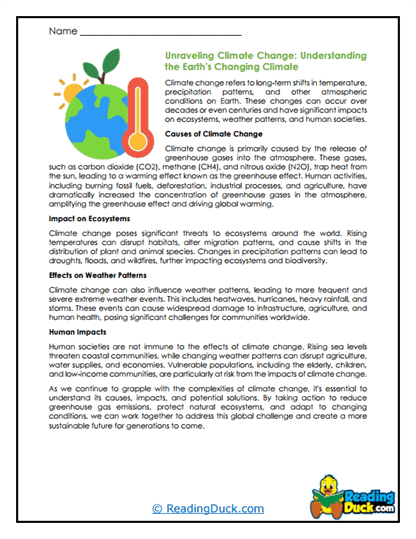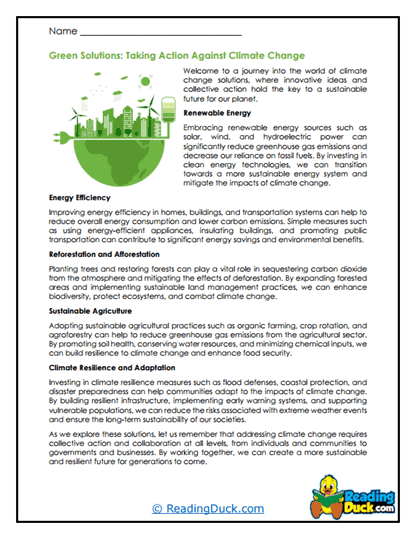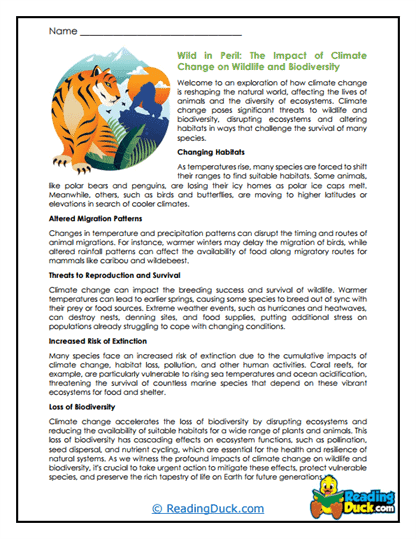Climate Change Worksheets
About Our Climate Change Worksheets
Our collection of Climate Change worksheets offers an in-depth and engaging exploration of one of the most urgent environmental issues of our time: climate change. This topic is crucial for understanding how human activities are altering the Earth's climate and the far-reaching impacts these changes have on ecosystems, weather patterns, and human societies. These worksheets are designed to enhance students' knowledge of climate change, its causes, effects, and the actions that can be taken to mitigate its impact.
This collection is a subtopic within Biology and Environmental Sciences and contains several worksheet sets. Each worksheet set includes:
- Multiple Choice Questions: These questions assess students' comprehension of the reading passage, ensuring they grasp the key concepts and details presented.
- Short Answer Questions: This section prompts students to write their responses, encouraging them to articulate their understanding in their own words. This exercise helps reinforce their knowledge and improves their ability to communicate scientific information effectively.
- Open-Ended Questions: These questions invite students to share their personal thoughts, opinions, and reflections on the material, fostering critical thinking and allowing them to connect more deeply with the content.
Each worksheet is accompanied by a detailed answer key, making it easy for educators and parents to review students' work. The worksheets are provided in PDF format, ensuring they can be easily viewed electronically, downloaded, and printed.
Understanding Climate Change: A Global Challenge
Climate change refers to significant changes in global temperatures and weather patterns over time. While climate change is a natural phenomenon, recent trends are largely driven by human activities, particularly the burning of fossil fuels, deforestation, and industrial processes. When introducing students to the topic of climate change, it’s important to highlight the scientific basis of the issue, its global implications, and the importance of collective action to address it.
The Science of Climate Change: Understanding the science behind climate change is essential for grasping the magnitude of the issue:
- Greenhouse Gases and the Greenhouse Effect: Greenhouse gases, such as carbon dioxide (CO2), methane (CH4), and nitrous oxide (N2O), trap heat in the Earth's atmosphere, creating the greenhouse effect. This natural process is essential for life, as it keeps the planet warm enough to sustain life. However, human activities have significantly increased the concentration of these gases, leading to an enhanced greenhouse effect and global warming.
- Carbon Cycle Disruption: The carbon cycle, which involves the movement of carbon among the atmosphere, oceans, soil, and living organisms, is being disrupted by human activities. The burning of fossil fuels and deforestation are adding more CO2 to the atmosphere than can be absorbed by natural processes, leading to an accumulation of greenhouse gases and an increase in global temperatures.
- Climate Models and Predictions: Scientists use climate models to predict future climate changes based on different scenarios of greenhouse gas emissions. These models help us understand potential impacts on global temperatures, sea levels, and weather patterns, providing valuable insights for planning and mitigation efforts.
Impacts of Climate Change: The effects of climate change are already being felt around the world, and these impacts are expected to intensify in the coming decades:
- Rising Temperatures: Global temperatures have been steadily rising, leading to more frequent and severe heatwaves, changes in precipitation patterns, and shifts in growing seasons. These changes affect agriculture, water supply, and human health.
- Melting Ice and Rising Sea Levels: The polar ice caps and glaciers are melting at an alarming rate, contributing to rising sea levels. This poses a significant threat to coastal communities, as higher sea levels increase the risk of flooding and erosion.
- Extreme Weather Events: Climate change is linked to an increase in the frequency and intensity of extreme weather events, such as hurricanes, droughts, and wildfires. These events have devastating effects on ecosystems, infrastructure, and human lives.
- Impact on Biodiversity: Many species are struggling to adapt to the rapid changes in their environments caused by climate change. This leads to shifts in species distribution, disruptions in food chains, and an increased risk of extinction for vulnerable species.
- Social and Economic Consequences: Climate change exacerbates social and economic challenges, particularly in developing countries. It can lead to food and water shortages, displacement of communities, and increased poverty and inequality.
Mitigation and Adaptation Strategies: Addressing climate change requires a combination of mitigation and adaptation strategies:
- Reducing Greenhouse Gas Emissions: Mitigation involves efforts to reduce or prevent the emission of greenhouse gases. This includes transitioning to renewable energy sources, improving energy efficiency, and adopting sustainable agricultural practices. International agreements like the Paris Agreement aim to limit global warming by setting targets for reducing emissions.
- Carbon Sequestration: Carbon sequestration involves capturing and storing carbon dioxide from the atmosphere or emissions. This can be done through natural processes, such as reforestation and soil management, or technological solutions, like carbon capture and storage (CCS).
- Adapting to Climate Change: Adaptation involves making adjustments to social, economic, and environmental practices to minimize the negative impacts of climate change. This includes building resilient infrastructure, developing drought-resistant crops, and implementing early warning systems for extreme weather events.
- Individual and Community Actions: Individuals and communities play a crucial role in combating climate change. Simple actions like reducing energy consumption, using public transportation, supporting local and sustainable products, and advocating for environmental policies can make a significant difference. Education and awareness are key to empowering people to take action.
Global Efforts to Combat Climate Change: Climate change is a global challenge that requires international cooperation:
- International Agreements: The Paris Agreement, adopted in 2015, is a landmark international treaty that brings countries together to limit global warming to well below 2°C above pre-industrial levels. The agreement emphasizes the need for global solidarity, financial support for developing countries, and regular updates to national commitments.
- Climate Justice: Climate change disproportionately affects vulnerable populations, including low-income communities, indigenous peoples, and small island nations. Climate justice seeks to address these inequalities by ensuring that the benefits and burdens of climate action are shared fairly and that those most affected by climate change have a voice in decision-making processes.
- Youth Activism: Young people around the world are leading the charge in demanding urgent action on climate change. Movements like Fridays for Future, led by youth activists like Greta Thunberg, have brought global attention to the need for immediate and ambitious climate action.
By exploring these aspects of climate change, students will gain a comprehensive understanding of the science, impacts, and solutions related to this global issue. These worksheets will guide students through the key concepts of climate change, encouraging them to think critically about the challenges we face and the actions needed to address them.
Creative Uses For These Worksheets
Here are four creative ideas on how teachers and parents can use these Climate Change worksheets in school or in a homeschool setup:
- Climate Change Simulation: Organize a classroom simulation where students take on the roles of different stakeholders (e.g., governments, businesses, environmental organizations, and citizens) and negotiate solutions to reduce greenhouse gas emissions. Use the worksheets to provide background knowledge and structure the simulation, allowing students to explore the complexities of climate action.
- Personal Carbon Footprint Project: Have students calculate their personal or household carbon footprint using online tools. They can use the worksheets to identify areas where they can reduce their carbon emissions and create an action plan. This project helps students apply their understanding of climate change to their daily lives and encourages them to take meaningful steps toward sustainability.
- Climate Change Debate: Divide the class into teams and host a debate on various aspects of climate change, such as the role of renewable energy, the effectiveness of international agreements, or the responsibilities of developed versus developing countries. The worksheets can serve as a foundation for students to gather evidence and form arguments, promoting critical thinking and public speaking skills.
- Art and Awareness Campaign: Encourage students to create artwork, posters, or digital media that communicate the importance of climate action. They can use the information from the worksheets to develop messages that raise awareness about climate change and inspire others to get involved. Display the finished projects in the school or share them online as part of a community awareness campaign.
The Importance of Learning About Climate Change
Understanding climate change is crucial for students because it is one of the most significant challenges facing our world today. Academically, it deepens their knowledge of science, environmental systems, and global interconnections, providing them with the tools to analyze and address complex issues. On a personal level, learning about climate change empowers students to make informed choices that contribute to a more sustainable future. By understanding the causes, effects, and solutions to climate change, students are better prepared to take action and advocate for the changes needed to protect the planet for future generations.









